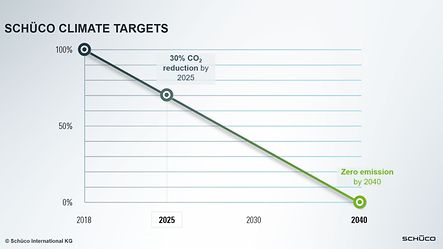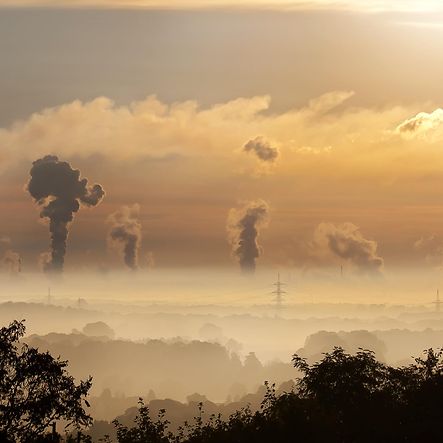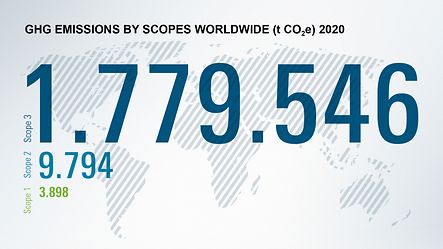
Climate protection
Zero emissions by 2040
Climate protection is one of the main parts of our sustainability strategy. In partnership with the WWF, we have developed science-based climate protection targets which will help to limit global warming to 1.5 degrees, in line with the Paris Agreement. We are therefore aiming to no longer generate any emissions that are harmful to the environment by 2040. We are calling the accompanying project "Emission Zero".

Ambitious climate targets – backed up by science
Schüco Germany has been systematically recording the company's climate-related emissions since 2011: the so-called carbon footprint. The basis for our ambitious targets is a neutral carbon footprint across the entire value chain, which we set out in our 2017-2018 sustainability report – as one of the few companies in the construction industry to do so. The absolute reductions in CO2 equivalents behind the targets have been checked by the SBTi (Science Based Targets initiative) and recognised as scientifically based. This means that they meet the level of decarbonisation stipulated by climate scientists in order to meet the 1.5° limit. Schüco is thereby joining the ranks of pioneering German businesses with climate objectives that are more ambitious than those set by the German government.
About the Corporate Carbon Footprint (Germany)
About the Corporate Carbon Footprint (Germany)
By regularly and systematically recording our corporate carbon footprint for Germany, we are laying the foundations for the reduction of CO2 emissions and improved energy and environmental management.The basis for the data collection is the standard DIN EN ISO 14064. Data from administration and production (energy consumption, water and waste water), transport logistics (internally and externally), business trips, journeys to and from work as well as paper consumption and printing is incorporated into the balance. The numbers are verified by TÜV NORD CERT and confirmed by issuing a certificate. Up until 2016, the total climate-related emissions sank to 27,888 tonnes of CO2 equivalents. From 2017 to 2019, however, Schüco saw an increase for its German sites. The reason for this development is the expansion of the transport logistics associated with the company's growth as well as an increase in business trips due to a higher number of employees.
Our successes
Before developing its climate protection targets, Schüco already employed diverse measures with the aim of reducing greenhouse gas emissions. For example, a building monitoring system was introduced across all of the sites, the heating in large sections of the headquarters in Bielefeld was switched to lower emission district heating, and new system management tools for optimising transport logistics were introduced. We switched to green energy back in 2012. This has made it possible for us to lower energy-related emissions to less than 10% of the previous value. Overall, these measures have allowed us to reduce our carbon footprint by 55% since 2011.

About the Science Based Targets initiative
About the Science Based Targets initiative
The Science Based Targets initiative was developed through a partnership between the UN Global Compact, the WWF, the World Resources Institute and non-profit organisation CDP. The initiative calls for the setting of scientifically substantiated climate goals and supports companies in transitioning to a carbon-free economy by independently evaluating the targets they have set. In addition to Schüco, over 1000 companies have answered the SBTi's call to establish science-based climate goals that are in harmony with the aims of the Paris Agreement to limit global warming to 1.5°C or significantly below 2°C.
Saving emissions holistically
The savings in CO2 equivalents that Schüco wants to achieve by 2040 relate to three areas, which are known as Scopes. In simple terms, Scope 1 relates to emissions that we ourselves produce through our energy consumption at Schüco. Scope 2 relates to the energy that we use, e.g. electricity that we need for lighting or our IT hardware. Scope 3 is the most challenging area and covers the entire lifecycle of our products. This includes the entire supply chain as well as the fabrication, use and disposal of our products. 99% of emissions fall under Scope 3; 86% of which are purchased goods and services. This means that Schüco has a direct influence over just a very small part of its emissions, and the climate protection targets can only be achieved in very close collaboration with suppliers.

Status quo
Between 2017 and 2019, the absolute amount of greenhouse gas emissions in Germany increased across all of the Scopes, despite a trend towards lower energy intensity. The main reason for this development is the expansion of the transport logistics associated with the company's growth as well as an increase in work-related travel due to a higher number of employees. When considered globally, since 2019 the absolute amount of greenhouse gas emissions has also been affected by a more precise basis for calculation that was introduced by Schüco to work out Science Based Climate Targets. Instead of relying on the average European values from the EPDs (“literature data”), we have been taking into account the actual emission data (“primary data”) for aluminium profiles made available by the largest press works. These figures are slightly, and sometimes significantly, above the average values utilised previously.
Due to the Covid-19 pandemic, the opposite trend was observed in 2020, with work travel by field sales staff (Scope 1) and business trips and kilometres travelled (Scope 3) having significantly decreased. This resulted in Scope 1 emissions being reduced by 10% to approx. 9800 t CO2e and Scope 3 emissions by almost 6% to 1,780,000 t CO2e. The Scope 2 emissions also went down, albeit by only 0.3% to approx. 3900 t CO2e. The total emissions from all three Scopes for 2020 total 1,793,238 t CO2e, which is 5.8% lower than 2019.

Facing challenges together
We are aware of the enormous potential in the construction industry: environmentally friendly construction is urgently required in order to meet the aims of the Paris Agreement.We want to set a good example with our ambitious climate protection targets and drive forward sustainable development in the industry. In partnership with the WWF, these targets will be turned into concrete measures and firmly anchored in our day-to-day business. As an independent environmental protection organisation, the WWF not only supports the further development and implementation of our measures, it also checks how effective they are. In this way, we can ensure that we are continuing to work purposefully towards a solution.
